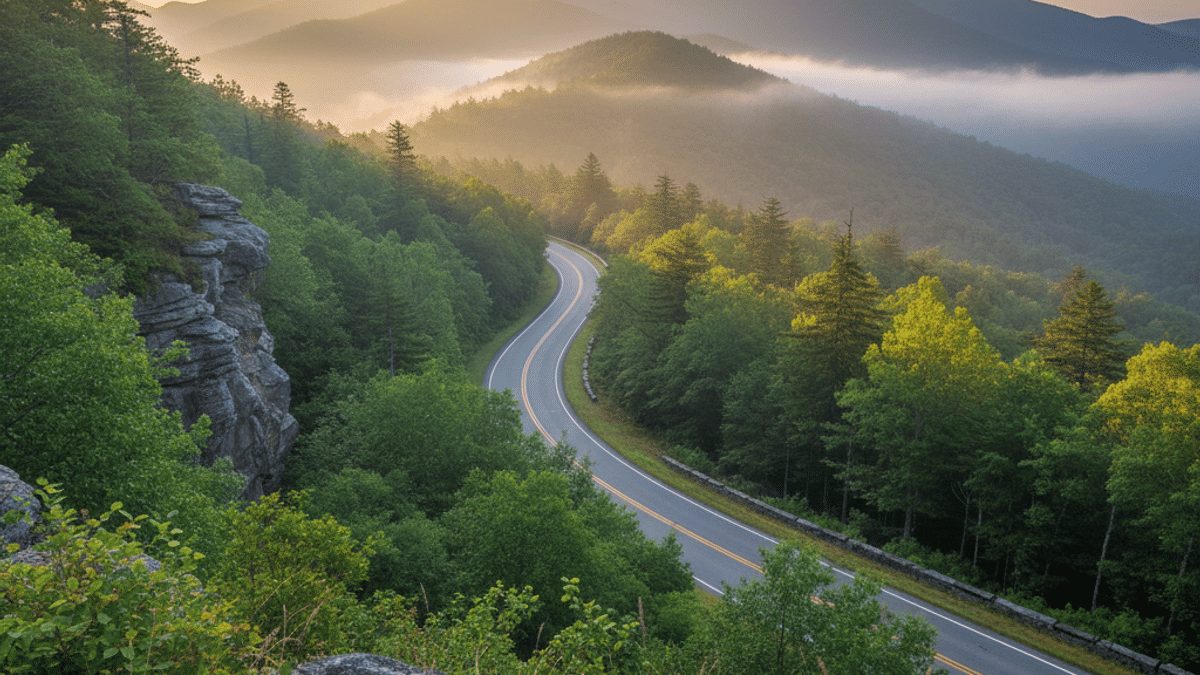Gatlinburg sits on the Tennessee side of the Great Smoky Mountains, right at the entrance to Great Smoky Mountains National Park. It is about 41 miles from McGhee Tyson Airport in Alcoa near Knoxville, typically an hour to a little over that by car depending on traffic. The aerial tram to Ober Mountain starts downtown, so the mountains feel close even before you drive into the park.
Asheville is in Western North Carolina on the French Broad River, surrounded by mountains and near Pisgah National Forest. Asheville Regional Airport is roughly 13 to 14 miles from the downtown area, commonly a 20 to 25 minute drive. The Blue Ridge Parkway threads along the city’s eastern rim and, as of mid September 2025, key stretches near Craggy Gardens have reopened after Helene repairs, with continuing spot closures posted by the National Park Service.
Getting from Gatlinburg to Asheville is a scenic trip across the Smokies. Drivers often go US 441 over Newfound Gap to Cherokee, then continue to Asheville, or they connect to the Blue Ridge Parkway when open. With normal stops it can be a half day drive for those who want overlooks and a scenic smoky view. Plan ahead and check current Parkway conditions if you want to travel along the Blue Ridge Parkway.
What Is The Housing Market Like?
The housing market in Gatlinburg leans toward cabins, chalets, and mountain homes, many with short term rental histories.
Redfin reported a median sale price of about $939,000 in August 2025, up 51.9 percent year over year, with a small number of monthly sales and longer market times. Adjacent ZIP 37738 shows a broader mix, with a median around $565,000 in August 2025 and slower sales pace than a year earlier.
The range on the ground is wide, from simple cottages close to the City of Gatlinburg to luxury view homes above Roaring Fork or near the Ober Gatlinburg corridor.
Asheville offers more urban and suburban variety. You will see craftsman bungalows in the Downtown area fringe, condos near Downtown Asheville, and single family homes across neighborhoods from North Asheville to South Asheville and Hendersonville Road.
Redfin placed Asheville’s August 2025 median at about $490,000, down 2.0 percent year over year, with a larger pool of sales and moderate days on market. That lines up with what you feel touring neighborhoods like the River Arts District and along the Blue Ridge Parkway access points, where price points vary by lot size and condition.
Rent patterns reflect the different housing stock. Zillow’s rental data in late September 2025 shows an average advertised rent around $2,300 in Gatlinburg and about $2,000 in Asheville. Both figures swing with seasonal listings, especially in the Smokies where vacation stock mixes with year round rentals. Use them as a snapshot, not a ceiling, and compare by property type and location.
What Is The Lifestyle And Community?
Gatlinburg reads as a classic mountain town focused on the Great Outdoors. The Great Smoky Mountains, the Gatlinburg Trail, and the Roaring Fork Motor Nature Trail start close to the City of Gatlinburg.
Ober Gatlinburg, now Ober Mountain, brings the Aerial Tramway right out of downtown, and the Aquarium of the Smokies anchors a walkable line of attractions.
Asheville balances outdoor access with an artsy, brewery forward culture. The Asheville Art Museum faces Pack Square, Downtown Asheville is filled with local food and beer, and the River Arts District houses hundreds of working studios.
The Biltmore Estate sits just south of downtown and remains the largest privately owned house in the country, a central draw along the Blue Ridge Parkway and within the Asheville Area. The vibe feels urban for a mountain city, with venues, galleries, and a steady calendar of events.
When you compare nightlife, Asheville offers more concentrated options near the Downtown area and in South Slope with brewery taprooms and music spots. Gatlinburg’s evenings run quieter once you step off the Parkway, with Ripley’s attractions, the Space Needle, and local restaurants keeping the lights on for after-hike dinners. The broader Sevier County corridor adds Dollywood and Pigeon Forge amusements for those who want shows and theme park days.
What Is The Cost Of Living?
Taxes create one of the clearer differences. Tennessee does not levy a state income tax on wages. The Hall income tax on interest and dividends was repealed for tax periods beginning January 1, 2021.
North Carolina levies a flat individual income tax, set at 4.25 percent for the 2025 tax year, and scheduled to decrease to 3.99 percent after 2025 under current law. For households with W-2 income, that line item alone can shift monthly budgets.
Property tax rates also vary. In Sevier County, the county property tax rate for 2024 is $1.48 per $100 of assessed value, with city rates added where applicable. In Asheville, the FY 2025 to 2026 rates total 54.66 cents per $100 for Buncombe County and 44.19 cents per $100 for the City of Asheville, with separate school and municipal district rates in some areas. Always combine county and city when you compare neighborhoods, since city limits materially change the bill.
Day to day costs like groceries and utilities usually track regional norms, but they can shift with the season or the part of town. Wages and service pricing have also been in flux after Helene, with the biggest moves showing up in Asheville’s hospitality scene.
How Do the Schools Compare?
Gatlinburg is served by Sevier County Schools. The district lists more than 14,000 students across 30 plus schools and publishes assessment, accountability, and testing updates through the Tennessee Department of Education’s report card portal.
Asheville students may attend Asheville City Schools or Buncombe County Schools depending on address. Asheville City Schools operates a small city district with open choice inside the system, while Buncombe County Schools covers suburban and rural areas around the city. North Carolina’s School Report Cards site provides performance, growth, and program details for individual schools and districts. Private and charter schools add more choices with their own application timelines.
Both areas offer extracurriculars tied to the setting. In Sevier County, outdoor clubs and seasonal sports often make use of the Gatlinburg Trail and nearby Cove areas. In Asheville, you see arts and crafts programs linked to the River Arts District, music, and mountain hiking groups tied to the Blue Ridge Mountains and Pisgah National Forest. Program availability changes by campus, so it helps to review each school’s activity roster.
Which Town Should You Choose?
Choose Gatlinburg if your priority is living at the entrance to the Great Smoky Mountain National Park, with trailheads and scenic drives like Roaring Fork Motor Nature Trail minutes away, and quick access to Pigeon Forge, Mountain Coasters, and Dollywood. The housing stock tilts toward cabins and view properties. Daily life follows the seasons, from leaf peeping to spring waterfalls. Tourism traffic is part of the rhythm, especially near Ripley’s Aquarium and along the Gatlinburg Space Needle corridor.
Choose Asheville if you want a small city feel with a walkable Downtown Asheville, galleries in the River Arts District, brewery clusters, and the Biltmore Estate close by. You can drive the Blue Ridge Parkway for a scenic smoky loop when sections are open, then be home in 15 to 25 minutes from most in-town neighborhoods. The housing mix is wider, from craftsman era streets to new infill, and the price point in mid 2025 has been more moderate than resort driven areas.
In both places, the Great Outdoors is the anchor. If you are comparing Asheville and Gatlinburg for day trip access, think about your routine. If you plan to hike three mornings a week, Gatlinburg’s proximity to the Entrance to the Great Smoky is hard to beat. If you want both trail time and urban arts, see Asheville as the base and keep a list of hikes along the Blue Ridge Parkway and in Pisgah National Forest.
FAQs
How long does it take to drive from Gatlinburg to Asheville?
With direct routing, the trip often runs about 2.5 to 3.5 hours depending on stops and road conditions. The fastest path is usually US 441 over Newfound Gap to Cherokee, then on to Asheville. Scenic Parkway segments can be slower and may have temporary closures, so check the National Park Service road status before you go.
What are the signature attractions in each place?
Gatlinburg offers Ripley’s Aquarium, the Gatlinburg Space Needle, Hollywood Star Cars Museum, and the aerial tram to Ober Mountain. Pigeon Forge adds Dollywood and the Titanic Museum Attraction. Asheville centers on Biltmore House, the Asheville Art Museum, the Asheville Pinball Museum, the River Arts District, and winery tastings on the estate.
How do housing prices compare right now?
As of August 2025, Redfin reported a median sale price around $939,000 in Gatlinburg, with limited monthly sales and longer market times, while Asheville’s median was about $490,000 with a larger transaction count. Neighborhood, view, and short term rental eligibility drive the spread more than a simple city average.
Are there differences in state and local taxes that affect budgets?
Yes. Tennessee does not tax wages at the state level and repealed its Hall income tax on dividends and interest for tax years beginning in 2021. North Carolina taxes individual income at a flat 4.25 percent for 2025, scheduled to decline to 3.99 percent after 2025 under current law. Local property tax rates also differ, so compare county and city rates for the address you are considering.
What is the “Asheville or Gatlinburg” choice like for outdoor access?
Both sit in the Smokies region. Gatlinburg touches the park boundary and the Gatlinburg Trail. Asheville is surrounded by the Blue Ridge Mountains, connects to the Blue Ridge Parkway, and sits near Pisgah National Forest. Waterfall hikes, Middle Prong Trail, scenic drives, and overlooks are common to both, with drive times and trail styles varying by side of the range.
Is there a difference in airport access and flight convenience?
Gatlinburg residents typically use McGhee Tyson Airport near Knoxville, about an hour away in normal conditions. Asheville residents use Asheville Regional Airport, about 20 to 25 minutes from the center of town. Both airports offer regional connections to larger hubs.
What about culture, food and beer, or live events?
Asheville’s Downtown area and South Slope concentrate brewery taprooms, galleries, and venues, with the Asheville Art Museum and River Arts District adding daytime options. Gatlinburg leans into visitor oriented attractions, aquarium shows, and mountain amusement, with Pigeon Forge shows and Dollywood a short drive away. The choice comes down to whether you want a city arts scene in daily life or to live at the front door of the Smokies’ tourist attractions.


 Facebook
Facebook
 X
X
 Pinterest
Pinterest
 Copy Link
Copy Link


